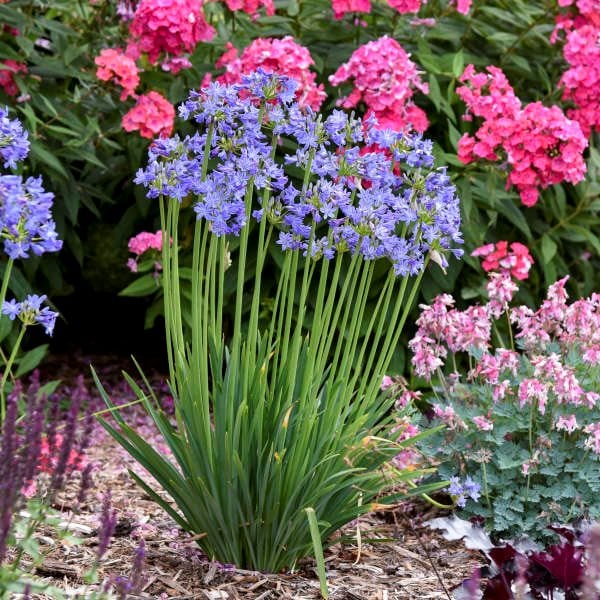Agapanthus Varieties: Selecting the very best for Your Landscape
Agapanthus Varieties: Selecting the very best for Your Landscape
Blog Article
Understanding the Art of Agapanthus Treatment: Crucial Actions for Healthy And Balanced Development and Dynamic Blooms
In the realm of gardening, the growing of agapanthus stands as a gratifying undertaking for those that look for to nurture these classy blooming plants. From picking the appropriate variety to mastering pruning techniques, the journey in the direction of growing prospering agapanthus plants is complex and holds the essential to opening the full potential of these botanical gems.

Picking the Right Agapanthus Variety

When choosing the ideal Agapanthus range for your garden, think about factors such as climate viability, bloom shade, and growth routine. Additionally, think about the climate in your region to make certain the Agapanthus selection you pick can prosper in your certain problems. Comprehending the growth practice of different Agapanthus selections is important for proper placement within your garden.
Ideal Planting Problems
Considering the optimum environmental requirements is crucial for successful Agapanthus growing. Agapanthus plants are sensitive to cool temperatures and must be safeguarded from frost throughout winter season months.
To make sure healthy growth and dynamic flowers, plant Agapanthus bulbs at a deepness of about 2-4 inches and room them 8-12 inches apart. Mulching around the base of the plants aids maintain wetness and suppresses weed growth.
Watering and Fertilizing Tips
Maintaining proper dampness levels and supplying necessary nutrients are essential components in the treatment regimen for Agapanthus plants. When it comes to watering Agapanthus, it is essential to strike an equilibrium. These plants like regularly moist dirt but are prone to root rot if overwatered.
Fertilizing Agapanthus is necessary for advertising healthy growth and respected blooms. Apply a balanced plant food, such as a 10-10-10 formula, in the early spring as new development emerges. Repeat this application every 6-8 weeks throughout the expanding period. Stay clear of excessive fertilization, as it can bring about rich vegetation at the cost of flowers. Constantly adhere to the supplier's guidelines for proper dilution and application approaches. By adhering to these watering and feeding pointers, you can ensure your Agapanthus plants view it grow and create dynamic, lasting blooms.
Trimming Methods for Agapanthus
Pruning Agapanthus plants at the appropriate times and with appropriate methods is essential for keeping their health and promoting optimum growth and flowering. The excellent time to prune Agapanthus remains in late winter season or early springtime before brand-new growth emerges. Start by removing any kind of dead or yellowing leaves near the base of the plant. Cut them as close to the ground as possible without harming the arising shoots.
Deadheading spent flowers can likewise reroute the plant's energy into creating more flowers rather than setting seeds. If you want to accumulate seeds for home propagation, leave some blossoms to mature and completely dry on the plant.
Keep in mind to make use of tidy, sharp tools to make accurate cuts and decrease the threat of presenting diseases. Agapanthus. Normal pruning will aid keep your Agapanthus looking cool and healthy while making sure a plentiful display screen of gorgeous flowers
Handling Common Insects and Illness
After view website making certain proper pruning methods for Agapanthus, it is vital to attend to usual parasites and illness that can influence the wellness and vitality of these plants. One usual insect that influences Agapanthus is the Agapanthus gall midge.
Furthermore, Agapanthus plants can suffer from origin rot if they are grown in improperly draining soil. By being watchful and taking timely action versus illness and pests, you can assist your Agapanthus plants thrive and create vibrant flowers. Agapanthus.

Conclusion
In conclusion, grasping the art of agapanthus care involves choosing the best variety, offering excellent growing conditions, correct watering and fertilizing, suitable pruning methods, and dealing with usual bugs and diseases. By adhering to these essential actions, you can make sure healthy growth and dynamic blossoms for your agapanthus plants. Keep in mind to routinely monitor and keep your plants to promote their total well-being and long life.
To make sure healthy development and dynamic blooms, plant Agapanthus bulbs at a depth of regarding 2-4 inches and space them 8-12 inches apart. By following these watering and fertilizing pointers, you can guarantee your Agapanthus plants prosper and create lively, lasting blossoms.
One usual insect that impacts Agapanthus is the Agapanthus gall midge. Additionally, Agapanthus plants can endure from root rot if they are grown in improperly draining pipes soil. By following these essential actions, you can ensure healthy and balanced development and dynamic flowers for your agapanthus plants.
Report this page